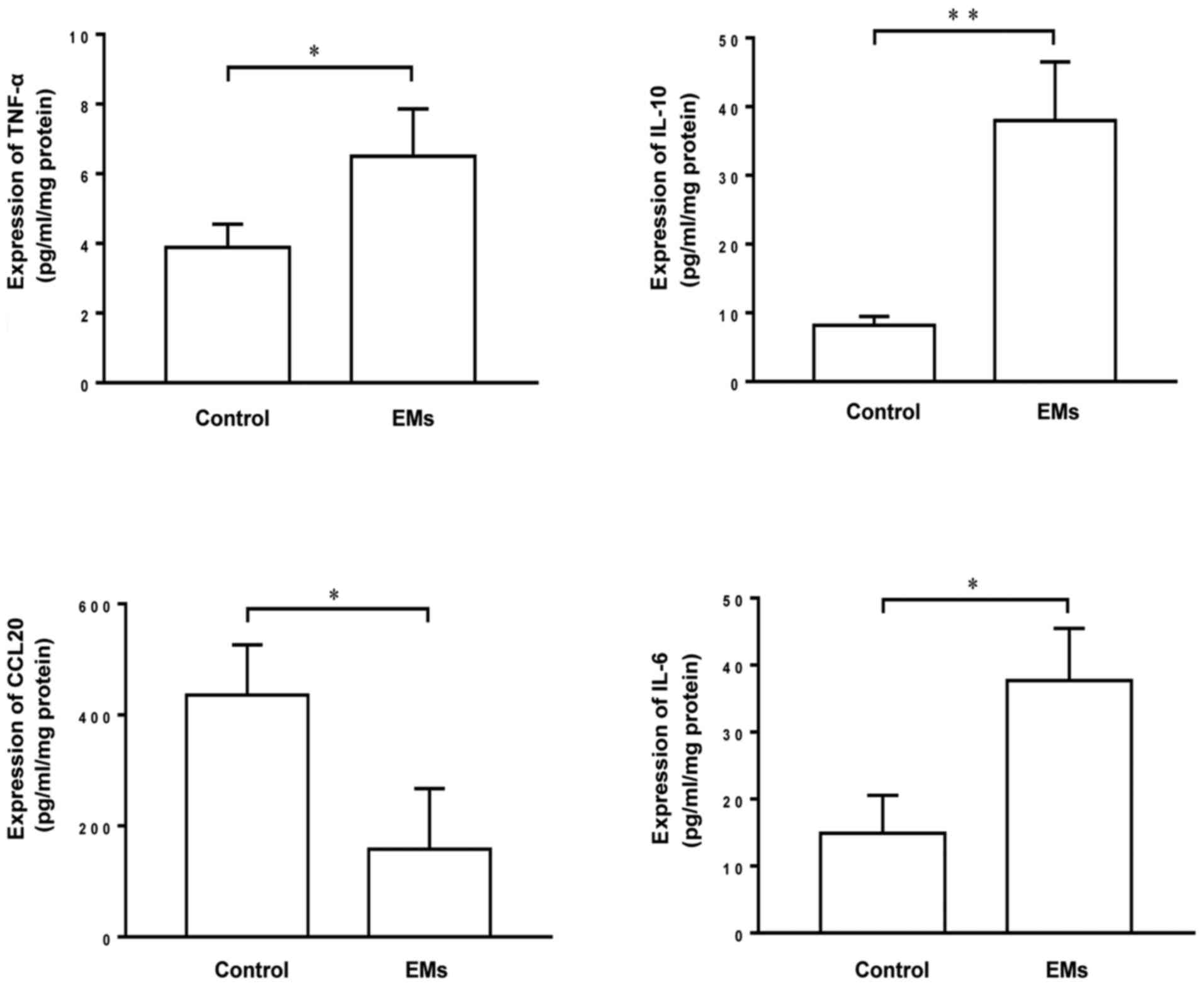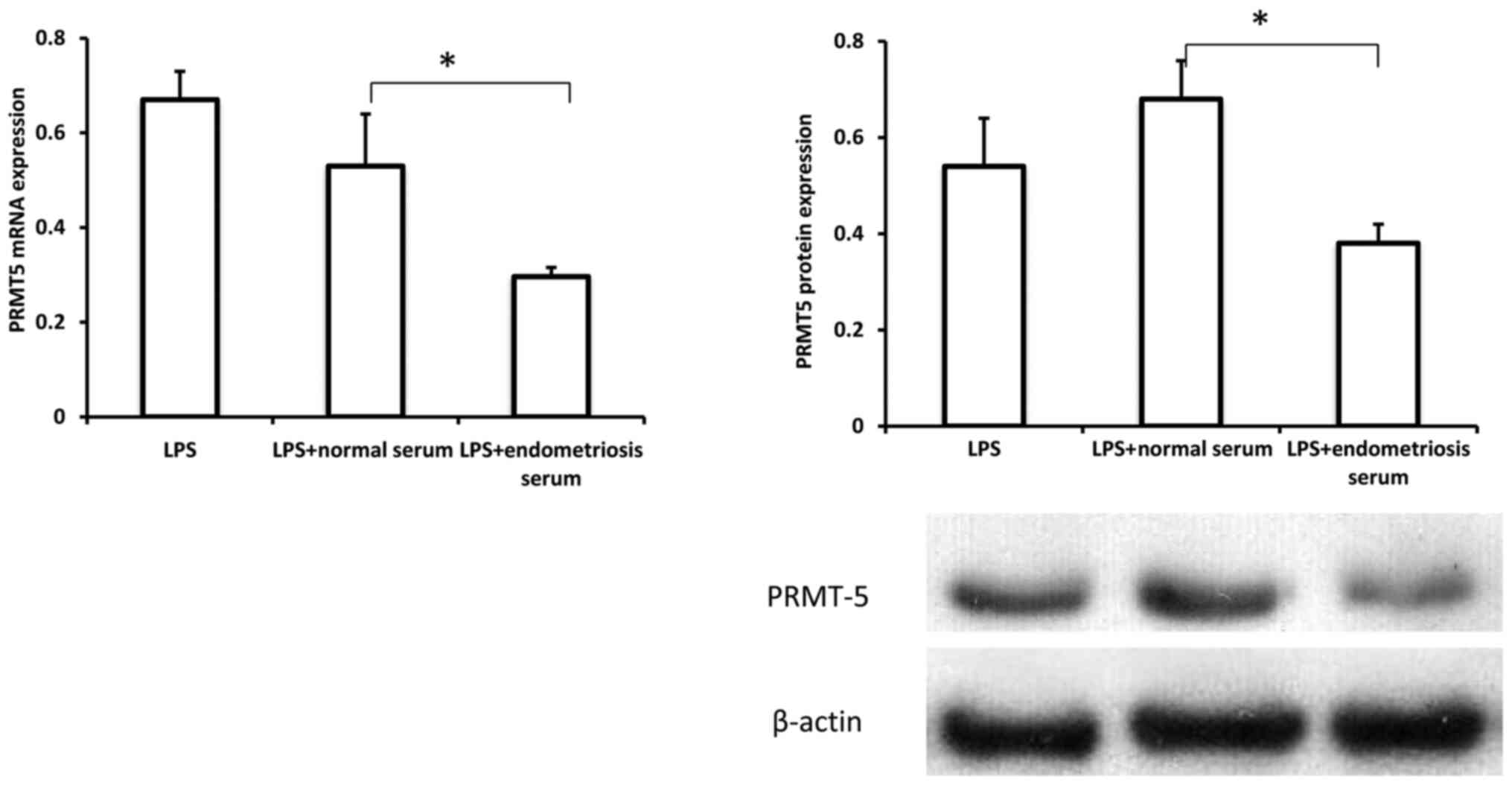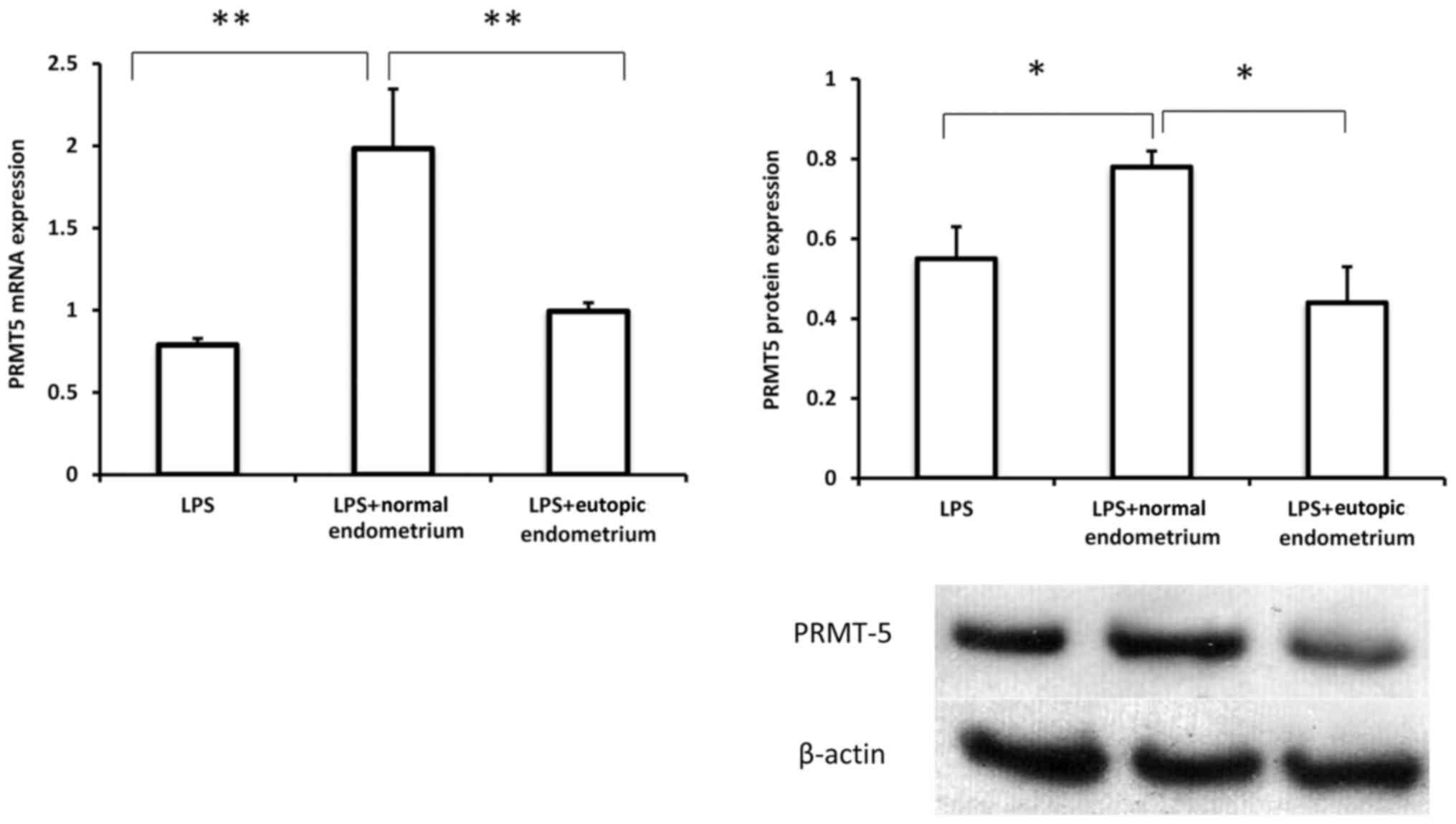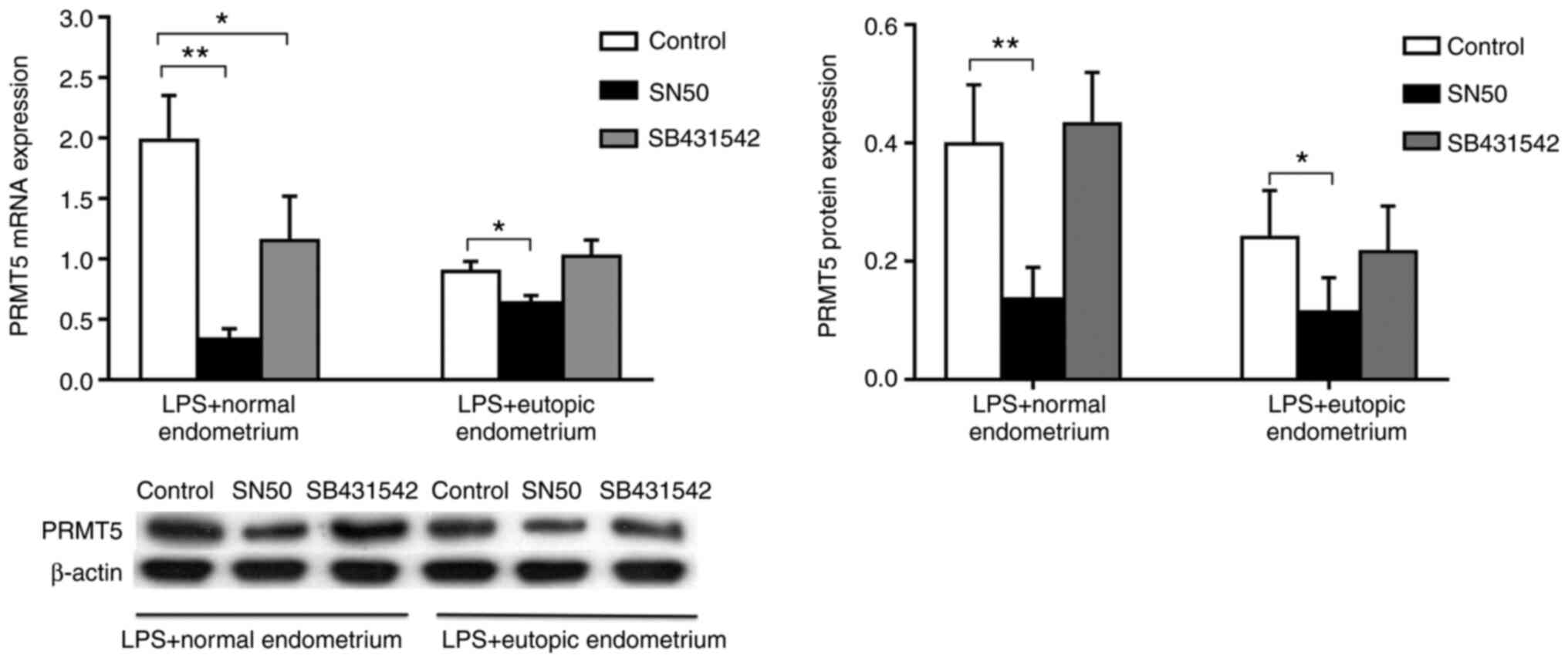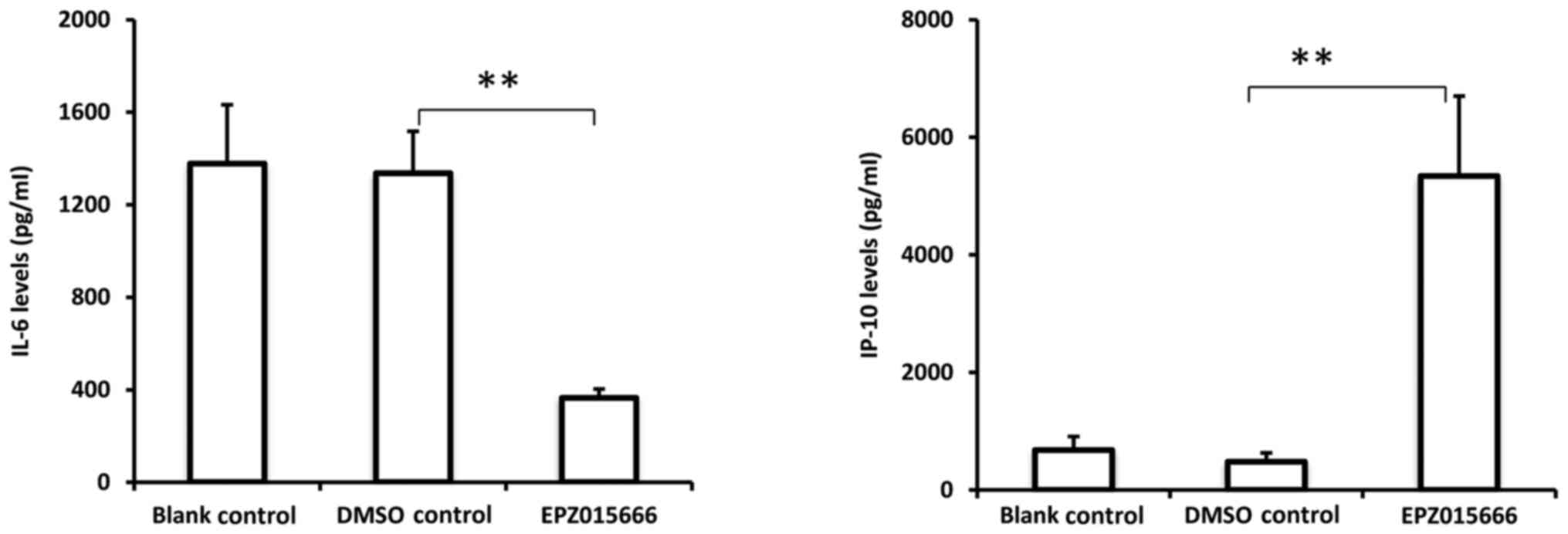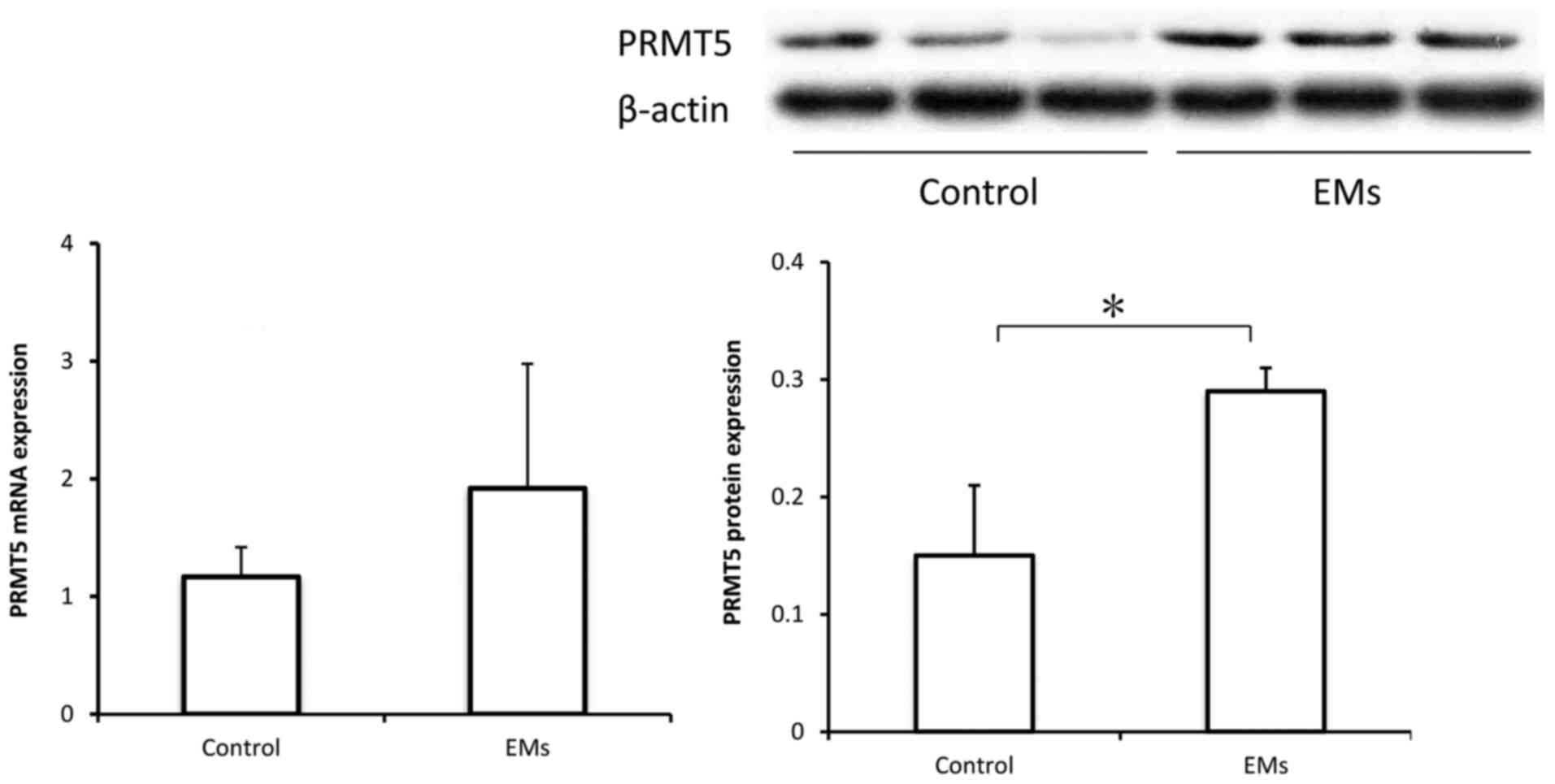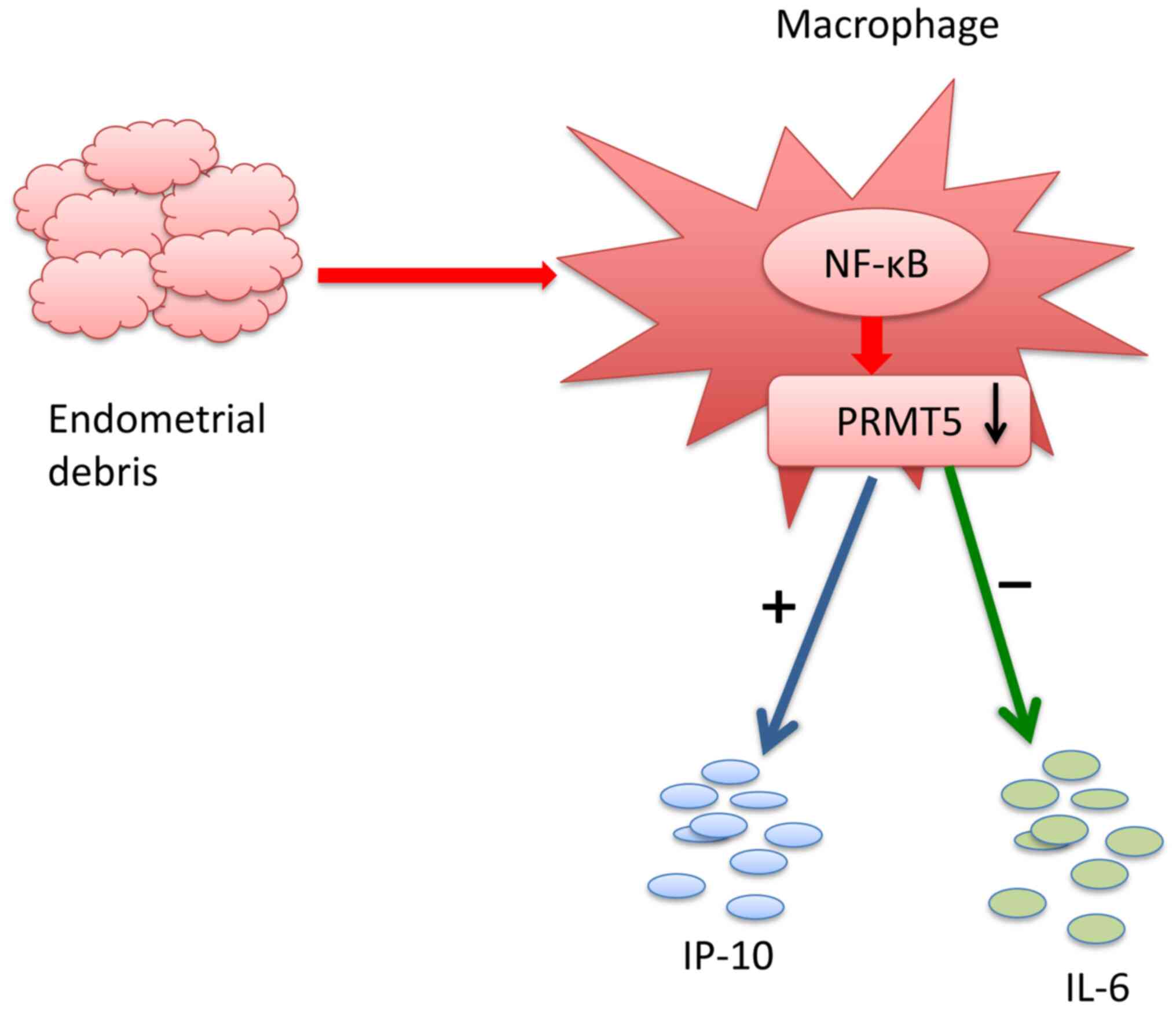Protein arginine methyltransferase 5 mediates THP‑1‑derived macrophage activation dependent on NF‑κB in endometriosis
- Authors:
- Published online on: July 15, 2021 https://doi.org/10.3892/etm.2021.10436
- Article Number: 1003
-
Copyright: © Chai et al. This is an open access article distributed under the terms of Creative Commons Attribution License.
Abstract
Introduction
Endometriosis (EMs) is a painful disorder in which the uterine lining (endometrium) grows abnormally outside the uterus, and it frequently occurs in the lower abdomen or pelvic area near the ovaries and fallopian tubes (1). Patients with endometriosis often suffer from dysmenorrhea, pain during sexual intercourse, lower abdominal pain and infertility (1).
Endometriosis is generally considered to be a disease associated with chronic inflammation (1). The tissues associated with endometriosis, especially in abdominal wall and ovarian endometriosis, are infiltrated by a large number of inflammatory cells, including CD3+ T cells, CD4+ T helper (Th) cells, CD8+ cytotoxic T cells, CD450+ memory T cells, CD68+ macrophages, CD20+ B cells, Th17 cells and regulatory T cells (2). M2 macrophages exist in greater numbers in endometriotic tissues compared with the surrounding tissues (3). In addition, Th17 cells and macrophages are abundant in the peritoneal fluid of patients with endometriosis, and the Th17 cell number has been indicated to positively correlate with the disease severity (4-6). Although peritoneal macrophages in patients with endometriosis produce and secrete large amounts of inflammatory mediators, such as TNF-α, IL-1β, IL-6 and vascular endothelial growth factor (VEGF) (7), the phagocytic ability of the macrophages is reduced. Therefore, the macrophages fail to effectively remove the uterine endometrial debris in the context of an inflammatory environment, thereby promoting the implantation of the endometrial cells and subsequent endometriosis (8).
Currently, major therapeutic strategies for endometriosis include surgical and medical treatment (9). However, surgical treatment for the removal of endometrioma is associated with a high risk of recurrence of endometriosis (10), and medical treatment causes a decrease in estrogen levels, leading to premature menopause (11). Therefore, there is increasing interest in the biological treatment of endometriosis through which the production of inflammatory cytokines may be inhibited by regulating the differentiation of macrophages and T cells.
Protein arginine methyltransferases (PRMTs) serve a role in protein methylation. PRMT5 catalyzes the formation of monomethylarginine and symmetric dimethylarginine in proteins, regulates a variety of target genes such as CDKN2A and multiple signaling pathways, such as the SNAIL/cadherin-1 pathway and the leukemia inhibitory factor/signal transducer and activator of transcription 3 signaling pathway (12), and participates in the post-transcriptional splicing and processing of RNA, cell proliferation, differentiation, apoptosis and tumorigenesis (12). A previous study demonstrated that PRMT5 is involved in the inflammatory response in endothelial cells, contributing to the pathogenesis of various diseases such as atherosclerosis (13). In addition, overexpression of PRMT5 has been indicated to promote the proliferation of memory T cells, thereby enhancing IL-2 expression in multiple sclerosis (14). It has been demonstrated that inhibition of PRMT5 expression can reduce the risk of colitis by promoting the regulatory T cell differentiation of Th cells and subsequently suppressing the production of TNF-α, IL-6 and IL-13(15).
As the production of cytokines by activated macrophages serves an important role in the pathogenesis of endometriosis, it was hypothesized that PRMT5 contributes to macrophage activation, thereby promoting endometriosis development. The present study examined the effects of serum and extracts of eutopic endometrium from patients with endometriosis on PRMT5 expression in THP-1-derived macrophages, as well as the underlying signaling pathways. Furthermore, the role of PRMT5 in macrophage activation in vitro and in vivo was also investigated.
Materials and methods
Reagents
Phorbol 12-myristate 13-acetate (PMA; cat. no. P8139) and lipopolysaccharide (LPS; cat. no. L2630) were purchased from Sigma-Aldrich (Merck KGaA). The Luminex cytokine panel kit (cat. no. LXSAHM) was purchased from R&D Systems, Inc. Rabbit PRMT5 antibody (cat. no. 18436-1-AP) was purchased from ProteinTech Group, Inc. IL-6 (cat. no. BMS213-2) and IFN-γ-induced protein 10 (IP-10) ELISA kits (cat. no. KAC2361) were purchased from Thermo Fisher Scientific, Inc. SB431542 (cat. no. S1067), which is used as an inhibitor of Smad 2/3(16), was purchased from Selleck Chemicals. NF-κB inhibitor SN50 (cat. no. SML1471) and PRMT5 inhibitor EPZ015666 were obtained from MedChemExpress.
Sample collection
A total of 25 female patients with ovarian cysts or infertility were enrolled from the Department of Obstetrics and Gynecology of The Second Xiangya Hospital of Central South University (Changsha, China) between December 2018 and October 2019. These patients were diagnosed with endometriosis by laparoscopic and histopathological examination. According to the revised American Fertility Society endometriosis classification, the study population included 2 stage I-II cases, 7 stage III cases and 16 stage IV cases (17). Of these, 20 cases were in the proliferative phase and 5 cases were in the secretory phase. The control group consisted of 12 patients who were diagnosed with cervical neoplasia or uterus septum and underwent laparoscopy, during which no endometrial lesions were observed in the pelvic cavity. All patients (aged 20-45 years) had regular periods and did not receive hormone therapy within 3 months prior to surgery. There were no significant differences in age, pregnancy, gravidity or proliferative vs. secretory phase between the two groups (Table I).
During surgery, endometrial biopsies were collected via excision under sterile conditions from the control and research groups, and they were promptly transported to the laboratory on ice in PBS. A portion of each tissue sample was fixed in 10% formalin solution for 12 h at room temperature. and then processed for histological examination to exclude pathological abnormalities. Hematoxylin-eosin staining was performed for histological examination, and the staining was completed according to the a previously described protocol (18).
The present study was approved by the Ethics Committee of The Second Xiangya Hospital of Central South University (Changsha, China). Written informed consent was obtained from all participants.
Isolation of peritoneal monocytes
During the laparoscopy, the peritoneal cavity was rinsed with 50 ml normal saline solution, and cell pellets were collected via centrifugation at 376 x g for 5 min at 4˚C. Monocytes were isolated following a standard protocol of Ficoll density gradient centrifugation (19-21). Briefly, Ficoll-loaded samples were centrifuged at 455 x g or 25 min at 20˚C. The buffy coat layer containing cells was then harvested and washed three times with PBS followed by centrifugation at 35 x g for 10 min at 20˚C to obtain monocytes. The monocytes were then stored at -80˚C until multiple samples were collected before performing subsequent reverse transcription-quantitative PCR (RT-qPCR) and western blot analyses.
Serum collection
Samples of 5 ml peripheral blood were collected from each patient into a coagulation tube. The serum was separated by centrifugation at 845 x g for 5 min at 4˚C and then stored at -80˚C until further use.
Preparation of endometrial homogenates
Endometrial homogenates were prepared as described previously (22). Briefly, endometrial tissues were excised during laparoscopy. A total of ~200 mg tissue was minced and homogenized in 5 ml RPMI-1640 (Gibco; Thermo Fisher Scientific, Inc.), followed by centrifugation at 9,391 x g for 10 min at 4˚C. The supernatant was collected, and protein concentration was determined using the BCA method. The samples were then stored at -80˚C until further use.
Cell culture and treatment
THP-1 cells were generously provided by Dr Joseph Huang (University of South Florida). The cells were grown in RPMI-1640 supplemented with 10% FBS (Gibco; Thermo Fisher Scientific, Inc.), 1% penicillin and 1% streptomycin at 37˚C in a humidified atmosphere with 5% CO2. THP-1 cells were differentiated into macrophage-like cells through treatment with 25 ng/ml PMA for 3 days at 37˚C in a humidified incubator with 5% CO2. THP-1-derived macrophage-like cells were pretreated with 100 ng/ml LPS for 24 h at 37˚C in a humidified incubator with 5% CO2 and then cultured in RPMI-1640 containing 10% serum from controls and patients with endometriosis for 6 days or cultured in homogenized solution of endometrium from controls and eutopic endometrium from patients with endometriosis (100 µl homogenized solution/ml medium) for 3 days. The inhibitors SN50 (50 µg/ml; treated for 1 h), SB431542 (10 µM; treated for 24 h) and EPZ015666 (10 µM; treated for 24 h) were added to the medium before treatment with the homogenized solution.
Western blot assay
THP-1 cells and the isolated peritoneal monocytes were washed with cold PBS and lysed with RIPA lysis buffer (Beyotime Institute of Biotechnology; cat. no. P0013B) on ice. Cell lysates were collected by centrifugation at 13,523 x g for 10 min at 4˚C, after which the supernatant was obtained and the protein concentration was determined using a BCA assay kit (Beyotime Institute of Biotechnology; cat. no. P0010S). Samples were then heated at 95˚C for 5 min in loading buffer. Protein samples (10 µg) were separated via 10% SDS-PAGE, transferred to a 0.2-µm nitrocellulose membrane, blocked with 5% nonfat milk in TBS containing 0.1% Tween-20 (TBST) for 2 h at room temperature, and incubated overnight with primary antibodies against PRMT5 (1:1,000) and β-actin (ProteinTech Group, Inc.; cat. no. 20536-1-AP; 1:10,000; internal control) at 4˚C. The membranes were then washed with TBST three times, incubated with HRP-Goat Anti-Rabbit IgG (H+L) (ProteinTech Group, Inc.; cat.no. SA00001-2; 1:5,000) for 1 h at room temperature, and then washed again with TBST three times. The chemiluminescence signal, visualized using SuperSignal West Pico PLUS (Thermo Fisher Scientific, Inc.; cat. no. 34580) was detected using the ChemiScope 5300 chemiluminescence system (Clinx Science Instruments Co. Ltd.) and quantified using Quantity One software (version 4.6.6; Bio-Rad Laboratories, Inc.).
RT-qPCR
Total RNA was extracted from THP-1 cells and the isolated peritoneal monocytes using TRIzol® reagent (Thermo Fisher Scientific, Inc.; cat. no. 15596026). cDNA was synthesized using the PrimeScript RT reagent kit with gDNA Eraser (Perfect Real Time; Takara, cat. no. RR047A) from 1 µg total RNA in accordance with the manufacturer's protocol. Relative gene expression levels were determined using the SYBR green PCR Master Mix (Applied Biosystems; Thermo Fisher Scientific; cat. no. 4309155) using the 2-ΔΔCq method (23) with normalization to β-actin expression. The thermocycling conditions were as follows: Initial denaturation at 95°C for 30 sec, followed by 40 cycles of 95°C for 5 sec, 60°C for 20 sec, 95°C for 1 sec, 65°C for 15 sec and 95°C for 1 sec for the dissociation curve. The primer sequences were as follows: PRMT5 forward, 5'-GGTGAACGCTTCCCTG-3' and reverse, 5'-TGAGACTACGGTCACTTGG-3'; β-actin forward, 5'-GAGCGCGGCTACAGCTT-3' and reverse, 5'-TCCTTAATGTCACGCACGCACGATTT-3'.
ELISA
After being treated as aforementioned, THP-1 cells with eutopic endometrial tissue extract from patients with endometriosis and the PRMT5 inhibitor EPZ015666, IL-6 and IP-10 levels in these cells were measured using ELISA kits (Thermo Fisher Scientific, Inc.) according to the manufacturer's instructions.
Luminex cytokine assay
TNF-α, IL-6, IL-10 and C-C motif chemokine 20 (CCL20) levels in endometrial extracts from patients with endometriosis and control individuals were determined using the Luminex cytokine kit (R&D Systems, Inc.) according to the manufacturer's instructions. Briefly, frozen endometrial extracts were homogenized in RIPA lysis buffer [Beyotime Institute of Biotechnology; cat. no. P0013B; 50 mM Tris (pH 7.4), 150 mM NaCl, 1% Triton X-100, 0.1% SDS, 1% sodium deoxycholate] with protease inhibitor cocktail (Sigma-Aldrich; Merck KGaA). Total protein levels were measured using the BCA method. TNF-α, IL-6, IL-10 and CCL20 levels were measured using a Luminex 200 analyzer (Luminex Corporation). The ratio of cytokine concentration to total protein concentration (pg/ml/mg protein) was used to determine differences between the two groups.
Statistical analysis
All quantitative data are presented as the mean ± SD. Statistical analysis was performed using SPSS software (version 17.0; SPSS, Inc.) and visualized using GraphPad Prism software (version 8.0; GraphPad Software, Inc.). In vitro cell experiments were repeated three times per sample, and the average values were used. Quantitative data were firstly examined for normal distribution using the Kolmogorov-Smirnov test, and data with equal variances were compared using one-way ANOVA followed by the Least Significant Difference test for comparisons among three groups, while unpaired t-test was used for comparisons between two groups. Alternatively, Mann-Whitney U tests were used for comparisons. Categorical variables were compared using the χ2 test. The Fisher's exact test was used to analyze the menstrual cycle variable in Table I. P<0.05 was considered to indicate a statistically significant difference.
Results
Cytokine levels in endometrial extracts from patients with endometriosis and control individuals
To investigate the differential expression of cytokines in patients with endometriosis and control individuals, the Luminex assay was used to compare the levels of TNF-α, IL-6, IL-10 and CCL20 in endometrial tissue extracts from these patients. The results demonstrated that the endometrial extracts of patients with endometriosis contained significantly higher levels of TNF-α, IL-6 and IL-10 and a decreased level of CCL20 compared with the endometrial extracts of control individuals (Fig. 1), suggesting that there are differences in the expression of TNF-α, IL-6, IL-10 and CCL20 that may contribute to the inflammatory response under pathological conditions.
Serum from patients with endometriosis inhibits PRMT5 expression in macrophages
To investigate the possible role of macrophage-derived PRMT5 in endometriosis development, the expression pattern of PRMT5 in THP-1 cells treated with serum from controls and patients with endometriosis in the presence of LPS was examined. As indicated in Fig. 2, both the mRNA and protein levels of PRMT5 were significantly decreased in THP-1 cells treated with serum from patients with endometriosis, compared with the levels in cells treated with serum from controls. These results revealed that PRMT5 expression in macrophages could be downregulated in the context of endometriosis, suggesting a potential role for macrophage-derived PRMT5 in the pathogenesis of endometriosis.
Extracts of eutopic endometrium suppress PRMT5 expression in macrophages
To further confirm the possible involvement of macrophage-expressed PRMT5 in endometriosis, PRMT5 expression was examined in THP-1 cells treated with extracts of normal and eutopic endometrium in the presence of LPS. As presented in Fig. 3, the extracts of normal endometrium induced a substantial increase in PRMT5 expression in THP-1 cells. However, treatment with extracts of eutopic endometrium significantly inhibited PRMT5 mRNA and protein expression in macrophages compared with extracts of normal endometrium, suggesting that macrophage-derived PRMT5 may serve a role in the interaction between macrophages and the eutopic endometrial microenvironment, which likely contributes to the inflammatory response under pathological conditions.
Macrophage expression of PRMT5 is regulated in a NF-κB signaling-dependent manner
To investigate the mechanisms underlying macrophage PRMT5 expression in endometriosis, the NF-κB inhibitor SN50 or the Smad2/3 inhibitor SB431542 was added to cells together with homogenized endometrial tissue to examine PRMT5 expression in THP-1 cells in the presence of LPS. The results revealed that SB431542 significantly inhibited the mRNA expression of PRMT5 in cells treated with extracts of normal endometrium. However, SB431542 treatment demonstrated no inhibition of PRMT5 protein expression in cells treated with extracts of normal endometrium. Additionally, no inhibition was demonstrated in cells treated with extracts of eutopic endometrium at both the mRNA and protein level. The results demonstrated that SN50, but not SB431542, markedly inhibited PRMT5 mRNA and protein expression in THP-1 cells treated with extracts of both normal and eutopic endometrium (Fig. 4). The results indicated that the endometrial microenvironment regulated macrophage PRMT5 expression through NF-κB signaling, but not Smad2/3 signaling.
PRMT5 mediates endometrial tissue extract-induced macrophage activation
To examine the function of PRMT5 in the interaction between macrophages and the endometrial microenvironment, THP-1 cells were treated with eutopic endometrial tissue extract from patients with endometriosis containing the PRMT5 inhibitor EPZ015666. As presented in Fig. 5, EPZ015666 significantly inhibited IL-6 secretion and promoted IP-10 secretion from THP-1 cells activated by eutopic endometrial tissue extract. These data indicated that PRMT5 is essential for endometrial tissue extract-induced macrophage activation, suggesting an important role for PRMT5 in mediating the interaction between macrophages and the endometrial microenvironment.
PRMT5 expression is upregulated in the peritoneal fluid monocytes of patients with endometriosis
To further investigate the possible role of PRMT5 expression in macrophages in endometriosis, peritoneal monocytes were collected from controls and patients with endometriosis for measuring PRMT5 expression. Previous studies have indicated that among the isolated CD68+ monocytes in peritoneal fluid, 85-95% are macrophages (20,21). As demonstrated in Fig. 6, the protein levels of PRMT5 were significantly increased in the peritoneal monocytes from patients with endometriosis, compared with those in the peritoneal monocytes from controls. However, while the mRNA levels of PRMT5 appeared to also be increased, the difference was not statistically significant.
Discussion
Previous studies have demonstrated that PRMT5 serves a critical role in inflammatory and autoimmune diseases, such as rheumatoid arthritis (14,15,22,24). However, the function of PRMT5 in macrophage activation has not yet been investigated. The present study demonstrated that the levels of cytokines in the endometrial extracts of patients with endometriosis were different from those in the endometrial extracts of control individuals. NF-κB-dependent PRMT5 may contribute to macrophage activation, resulting in the production of the pro-inflammatory mediators IL-6 and IP-10, which likely contributes to the pathogenesis of endometriosis (25).
Currently, the pathogenesis of endometriosis is incompletely understood. A generally accepted concept is the theory of retrograde menstruation, in which regurgitated endometrial cells during menstruation recruit blood monocytes into the peritoneal fluid and secrete large amounts of inflammatory mediators, such as TNF-α, IL-1β, IL-6, IL-8 and VEGF, thereby promoting invasion and angiogenesis of ectopic endometrial implants and subsequent lesion formation (26). It has been indicated that establishment and development of ectopic endometrial lesions are significantly suppressed if peritoneal macrophages are depleted in a mouse model of endometriosis (27), suggesting that interactions between macrophages and the ectopic endometrium may serve a key role in the development of endometriosis.
In the present study, the expression levels of cytokines TNF-α, IL-6 and IL-10 were increased and that of CCL20 was decreased in the endometrial extracts of patients with endometriosis compared with the endometrial extracts of control patients. The mechanisms via which cytokines regulate macrophage activation are relatively complex, as it has been reported that macrophages can be activated and differentiated into distinct subtypes under different cytokine-mediated microenvironments (28). A recent study demonstrated that in response to TNF-α, human endometrial stromal cell-derived IL-6 and monocyte chemoattractant protein-1 stimulated peritoneal macrophages toward M2-polarization, which could modulate endometriosis (29). It was also reported that osteoblast-derived CCL20 stimulates the recruitment of macrophages and T cells (30). In the current study, PRMT5 expression in THP-1-derived macrophages was markedly downregulated following treatment with either serum or extracts of eutopic endometrium from patients with endometriosis compared with the serum or extracts of control endometrium samples, indicating that PRMT5 may be a regulator of macrophage activation in the development of endometriosis. Consistently, overexpression of PRMT5 has been indicated to enhance the expression of major histocompatibility complex class II (MHC II) in macrophages (31). MHC II-dependent antigen presentation to CD4+ T cells orchestrates the interplay among a variety of immune cell types and regulates the humoral and cell-mediated immune responses (32). Therefore, MHC II expression may be inhibited via the downregulation of macrophage PRMT5 in the context of the microenvironment of eutopic endometrial lesions, resulting in a suppressed macrophage-dependent antigen-presenting capacity and an accelerated development of ectopic endometrial lesions.
NF-κB, a major transcriptional factor of the inflammatory response in immunity, has been revealed to be involved in the pathophysiology of endometriosis (33). PRMT5 is responsible for the methylation of Arg30 on the NF-κB subunit p65, and may thereby regulate the expression of NF-κB target genes. In addition, PRMT5 activates NF-κB by binding to TNF-related apoptosis-inducing ligand (34). On the other hand, NF-κB may promote PRMT5 expression in Th cells as an upstream regulator of PRMT5(14), which is consistent with the present finding that the NF-κB inhibitor SN50 suppressed PRMT5 expression in THP-1-derived macrophages treated with extracts of either normal or eutopic endometrium. Further investigation is required to elucidate the molecular mechanisms underlying the interplay between PRMT5 and NF-κB.
EPZ015666 is a selective inhibitor of PRMT5 that can specifically block PRMT5 activity (35). A previous study has revealed that EPZ015666 inhibited IL-6 and IL-8 production by fibroblast-like synoviocytes (24), which supports the present finding that EPZ015666 reduced the secretion of IL-6 while increasing the secretion of IP-10 by THP-1 cells treated with extracts of eutopic endometrium. Both studies verified that PRMT5 possesses proinflammatory properties. Interestingly, the effect of PRMT5 on IP-10 production appears to depend on the cell type involved in the inflammatory response. For example, PRMT5 has been indicated to promote TNF-α-induced IP-10 production by endothelial cells (36).
Previous studies confirmed that 85-95% of the isolated monocytes in peritoneal fluid are macrophages (20,21). To further investigate the possible role of PRMT5 expression in peritoneal macrophages in endometriosis, peritoneal monocytes were obtained from patients and it was indicated that PRMT5 protein expression in peritoneal monocytes was significantly upregulated in patients with endometriosis compared with controls. Possible explanations for this discrepancy are as follows: i) T cells and natural killer (NK) cells are present in peritoneal fluid, although peritoneal macrophages are highly abundant; ii) the cytokines released by ectopic endometrium influence PRMT5 expression in peritoneal monocytes; and iii) the majority of samples were collected from patients with stage III-IV endometriosis. Due to the different immune profiles of eutopic endometrium between endometriosis stages I-II and III-IV, more samples are required from patients with stage I-II endometriosis to further examine the association between PRMT5 expression and the development of endometriosis (37).
Taken together, the results of the present study indicated that eutopic endometrium in patients with endometriosis induced a reduction in PRMT5 expression in THP-1-derived macrophages, resulting in the inhibition of IL-6 production and the increased production of IP-10 (Fig. 7). The mechanism of PRMT5 in endometriosis remains unknown. IP-10 is a key chemokine of Th1 and NK cells and the increase in IP-10 production reduces the number of Th1 and NK cells recruited to the peritoneal fluid (38). The inability of these cells to effectively clear peritoneal endometrial cells results in the successful establishment of endometrial implants (26). In this context, PRMT5 appears to be a novel regulator of macrophage activation.
Acknowledgements
Not applicable.
Funding
Funding: No funding was received.
Availability of data and materials
The datasets generated and analyzed during the current study are not publicly available due to restricting patient privacy regulations by the different countries but are available from the corresponding author on reasonable request.
Authors' contributions
XW and XC collected and interpreted the patient samples and data. XC and LH performed the experiments of the study. XC and HD analyzed the data. HD designed the study was a major contributor in writing of the manuscript. All authors read and approved the final manuscript. HD and XC confirm the authenticity of all the raw data.
Ethics approval and consent to participate
The present study was approved by the Ethics Committee of The Second Xiangya Hospital of Central South University (Changsha, China). Written informed consent was obtained from all participants.
Patient consent for publication
Not applicable.
Competing interests
The authors declare that they have no competing interests.
References
|
Mehedintu C, Plotogea MN, Ionescu S and Antonovici M: Endometriosis still a challenge. J Med Life. 7:349–357. 2014.PubMed/NCBI | |
|
Scheerer C, Bauer P, Chiantera V, Sehouli J, Kaufmann A and Mechsner S: Characterization of endometriosis-associated immune cell infiltrates (EMaICI). Arch Gynecol Obstet. 294:657–664. 2016.PubMed/NCBI View Article : Google Scholar | |
|
Bacci M, Capobianco A, Monno A, Cottone L, Di Puppo F, Camisa B, Mariani M, Brignole C, Ponzoni M, Ferrari S, et al: Macrophages are alternatively activated in patients with endometriosis and required for growth and vascularization of lesions in a mouse model of disease. Am J Pathol. 175:547–556. 2009.PubMed/NCBI View Article : Google Scholar | |
|
Ahn SH, Edwards AK, Singh SS, Young SL, Lessey BA and Tayade C: IL-17A contributes to the pathogenesis of endometriosis by triggering proinflammatory cytokines and angiogenic growth factors. J Immunol. 195:2591–2600. 2015.PubMed/NCBI View Article : Google Scholar | |
|
Antsiferova YS, Sotnikova NY, Posiseeva LV and Shor AL: Changes in the T-helper cytokine profile and in lymphocyte activation at the systemic and local levels in women with endometriosis. Fertil Steril. 84:1705–1711. 2005.PubMed/NCBI View Article : Google Scholar | |
|
Gogacz M, Winkler I, Bojarska-Junak A, Tabarkiewicz J, Semczuk A, Rechberger T and Adamiak A: Increased percentage of Th17 cells in peritoneal fluid is associated with severity of endometriosis. J Reprod Immunol. 117:39–44. 2016.PubMed/NCBI View Article : Google Scholar | |
|
Izumi G, Koga K, Takamura M, Makabe T, Satake E, Takeuchi A, Taguchi A, Urata Y, Fujii T and Osuga Y: Involvement of immune cells in the pathogenesis of endometriosis. J Obstet Gynaecol Res. 44:191–198. 2018.PubMed/NCBI View Article : Google Scholar | |
|
Berbic M, Schulke L, Markham R, Tokushige N, Russell P and Fraser IS: Macrophage expression in endometrium of women with and without endometriosis. Hum Reprod. 24:325–332. 2009.PubMed/NCBI View Article : Google Scholar | |
|
Kim TH, Yoo JY, Choi KC, Shin JH, Leach RE, Fazleabas AT, Young SL, Lessey BA, Yoon HG and Jeong JW and Jeong JW: Loss of HDAC3 results in nonreceptive endometrium and female infertility. Sci Transl Med. 11(eaaf7533)2019.PubMed/NCBI View Article : Google Scholar | |
|
Bozdag G: Recurrence of endometriosis: Risk factors, mechanisms and biomarkers. Womens Health (Lond). 11:693–699. 2015.PubMed/NCBI View Article : Google Scholar | |
|
Gheorghisan-Galateanu AA and Gheorghiu ML: Hormonal therapy in women of reproductive age with endometriosis: An update. Acta Endocrinol (Buchar). 15:276–281. 2019.PubMed/NCBI View Article : Google Scholar | |
|
Karkhanis V, Hu YJ, Baiocchi RA, Imbalzano AN and Sif S: Versatility of PRMT5-induced methylation in growth control and development. Trends Biochem Sci. 36:633–641. 2011.PubMed/NCBI View Article : Google Scholar | |
|
Bandyopadhyay S, Harris DP, Adams GN, Lause GE, McHugh A, Tillmaand EG, Money A, Willard B, Fox PL and Dicorleto PE: HOXA9 methylation by PRMT5 is essential for endothelial cell expression of leukocyte adhesion molecules. Mol Cell Biol. 32:1202–1213. 2012.PubMed/NCBI View Article : Google Scholar | |
|
Webb LM, Amici SA, Jablonski KA, Savardekar H, Panfil AR, Li L, Zhou W, Peine K, Karkhanis V, Bachelder EM, et al: PRMT5-selective inhibitors suppress inflammatory T cell responses and experimental autoimmune encephalomyelitis. J Immunol. 198:1439–1451. 2017.PubMed/NCBI View Article : Google Scholar | |
|
Zheng Y, Huang L, Ge W, Yang M, Ma Y, Xie G, Wang W, Bian B, Li L, Nie H and Shen L: Protein arginine methyltransferase 5 inhibition upregulates Foxp3(+) regulatory T cells frequency and function during the ulcerative colitis. Front Immunol. 8(596)2017.PubMed/NCBI View Article : Google Scholar | |
|
Bian X, Li B, Yang J, Ma K, Sun M, Zhang C and Fu X: Regenerative and protective effects of dMSC-sEVs on high-glucose-induced senescent fibroblasts by suppressing RAGE pathway and activating Smad pathway. Stem Cell Res Ther. 11(166)2020.PubMed/NCBI View Article : Google Scholar | |
|
Johnson NP, Hummelshoj L, Adamson GD, Keckstein J, Taylor HS, Abrao MS, Bush D, Kiesel L, Tamimi R, Sharpe-Timms KL, et al: World endometriosis society consensus on the classification of endometriosis. Hum Reprod. 32:315–324. 2017.PubMed/NCBI View Article : Google Scholar | |
|
Fischer AH, Jacobson KA, Rose J and Zeller R: Hematoxylin and eosin staining of tissue and cell sections. CSH Protoc. 2008(pdb.prot4986)2008.PubMed/NCBI View Article : Google Scholar | |
|
Xie Q, He H, Wu YH, Zou LJ, She XL, Xia XM and Wu XQ: Eutopic endometrium from patients with endometriosis modulates the expression of CD36 and SIRP-α in peritoneal macrophages. J Obstet Gynaecol Res. 45:1045–1057. 2019.PubMed/NCBI View Article : Google Scholar | |
|
Wu XQ, Fang XL, Lin QH, Huang FY and Xia XM: VEGF production and its receptor expression of MPhis in peritoneal fluid. Xi Bao Yu Fen Zi Mian Yi Xue Za Zhi. 19:462–465. 2003.PubMed/NCBI(In Chinese). | |
|
McLaren J, Prentice A, Charnock-Jones DS, Millican SA, Müller KH, Sharkey AM and Smith SK: Vascular endothelial growth factor is produced by peritoneal fluid macrophages in endometriosis and is regulated by ovarian steroids. J Clin Invest. 98:482–489. 1996.PubMed/NCBI View Article : Google Scholar | |
|
Dasgupta S, Bhattacharya-Chatterjee M, O'Malley BW Jr and Chatterjee SK: Inhibition of NK cell activity through TGF-beta 1 by down-regulation of NKG2D in a murine model of head and neck cancer. J Immunol. 175:5541–5550. 2005.PubMed/NCBI View Article : Google Scholar | |
|
Livak KJ and Schmittgen TD: Analysis of relative gene expression data using real-time quantitative PCR and the 2(-Delta Delta C(T)) method. Methods. 25:402–408. 2001.PubMed/NCBI View Article : Google Scholar | |
|
Chen D, Zeng S, Huang M, Xu H, Liang L and Yang X: Role of protein arginine methyltransferase 5 in inflammation and migration of fibroblast-like synoviocytes in rheumatoid arthritis. J Cell Mol Med. 21:781–790. 2017.PubMed/NCBI View Article : Google Scholar | |
|
Li S, Fu X, Wu T, Yang L, Hu C and Wu R: Role of interleukin-6 and its receptor in endometriosis. Med Sci Monit. 23:3801–3807. 2017.PubMed/NCBI View Article : Google Scholar | |
|
Ulukus M and Arici A: Immunology of endometriosis. Minerva Ginecol. 57:237–248. 2005.PubMed/NCBI | |
|
Haber E, Danenberg HD, Koroukhov N, Ron-El R, Golomb G and Schachter M: Peritoneal macrophage depletion by liposomal bisphosphonate attenuates endometriosis in the rat model. Hum Reprod. 24:398–407. 2009.PubMed/NCBI View Article : Google Scholar | |
|
Liu G and Yang H: Modulation of macrophage activation and programming in immunity. J Cell Physiol. 228:502–512. 2013.PubMed/NCBI View Article : Google Scholar | |
|
Li MZ, Wu YH, Ali M, Wu XQ and Nie MF: Endometrial stromal cells treated by tumor necrosis factor-α stimulate macrophages polarized toward M2 via interleukin-6 and monocyte chemoattractant protein-1. J Obstet Gynaecol Res. 46:293–301. 2020.PubMed/NCBI View Article : Google Scholar | |
|
Doucet M, Jayaraman S, Swenson E, Tusing B, Weber KL and Kominsky SL: CCL20/CCR6 signaling regulates bone mass accrual in mice. J Bone Miner Res. 31:1381–1390. 2016.PubMed/NCBI View Article : Google Scholar | |
|
Fan Z, Kong X, Xia J, Wu X, Li H, Xu H, Fang M and Xu Y: The arginine methyltransferase PRMT5 regulates CIITA-dependent MHC II transcription. Biochim Biophys Acta. 1859:687–696. 2016.PubMed/NCBI View Article : Google Scholar | |
|
Ding Q, Chen J, Wei X, Sun W, Mai J, Yang Y and Xu Y: RAFTsomes containing epitope-MHC-II complexes mediated CD4+ T cell activation and antigen-specific immune responses. Pharm Res. 30:60–69. 2013.PubMed/NCBI View Article : Google Scholar | |
|
González-Ramos R, Defrère S and Devoto L: Nuclear factor-kappaB: A main regulator of inflammation and cell survival in endometriosis pathophysiology. Fertil Steril. 98:520–528. 2012.PubMed/NCBI View Article : Google Scholar | |
|
Wei H, Wang B, Miyagi M, She Y, Gopalan B, Huang DB, Ghosh G, Stark GR and Lu T: PRMT5 dimethylates R30 of the p65 subunit to activate NF-κB. Proc Natl Acad Sci USA. 110:13516–13521. 2013.PubMed/NCBI View Article : Google Scholar | |
|
Chan-Penebre E, Kuplast KG, Majer CR, Boriack-Sjodin PA, Wigle TJ, Johnston LD, Rioux N, Munchhof MJ, Jin L, Jacques SL, et al: A selective inhibitor of PRMT5 with in vivo and in vitro potency in MCL models. Nat Chem Biol. 11:432–437. 2015.PubMed/NCBI View Article : Google Scholar | |
|
Harris DP, Bandyopadhyay S, Maxwell TJ, Willard B and DiCorleto PE: Tumor necrosis factor (TNF)-α induction of CXCL10 in endothelial cells requires protein arginine methyltransferase 5 (PRMT5)-mediated nuclear factor (NF)-κB p65 methylation. J Biol Chem. 289:15328–15339. 2014.PubMed/NCBI View Article : Google Scholar | |
|
Poli-Neto OB, Meola J, Rosa-E-Silva JC and Tiezzi D: Transcriptome meta-analysis reveals differences of immune profile between eutopic endometrium from stage I-II and III-IV endometriosis independently of hormonal milieu. Sci Rep. 10(313)2020.PubMed/NCBI View Article : Google Scholar | |
|
Nagarsheth N, Wicha MS and Zou W: Chemokines in the cancer microenvironment and their relevance in cancer immunotherapy. Nat Rev Immunol. 17:559–572. 2017.PubMed/NCBI View Article : Google Scholar |



